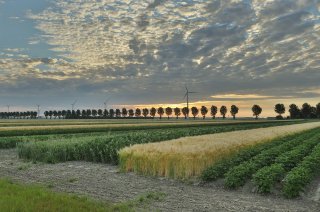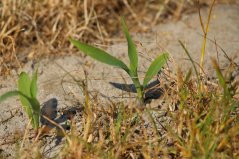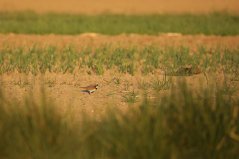
Longread
Sustainable and yet highly productive agriculture
The Netherlands is committed to developing a sustainable and highly productive food system, with less use of fertilisers, water and pesticides, and more biodiversity and crop diversity. To help achieve this goal, WUR is conducting research into ecological arable farming systems based on strip cropping and mixed cropping.
Uniform fields with monocultures of ryegrass, maize, potatoes or wheat are a familiar sight in the Netherlands. But motorists driving down the A6 motorway near Almere are offered a different view: a mosaic of different crops growing side by side in the same field. These strip cropping fields are managed by ERF BV (Exploitant Reservegronden Flevoland).
ERF BV is the largest organic vegetable grower in the Netherlands. The company manages 1,000 hectares of arable farmland in Flevoland and has been experimenting with strip cropping on part of this land since 2015. ERF grows potatoes, field beans and various other vegetables such as celeriac, parsnips, Brussels sprouts, broccoli and cauliflower in these fields. Dirk van Apeldoorn is a researcher with WUR’s chair group Farming Systems Ecology and business unit Field Crops and has been conducting measurements and offering the company advice for improvements.
Advantage of strip cropping
ERF initially started growing various potato varieties and other vegetables side by side in 6-metre strips. The company then went on to test strips of varying widths (6, 12 and 24 metres). These are logical widths, says Van Apeldoorn, because the farm implements used for fertilisation, crop management and harvesting are typically multiples of 6 metres wide. He found that the yields of the cropping strips were similar to those of the monocultures, as was the labour efficiency of the organic farming system. However, an important advantage was that the crops in the 6-metre strips were less affected by pests and diseases.
Farm of the Future in Lelystad
Since 2010, WUR has also been experimenting with strip cropping at their agroecology and technology research lab in Lelystad. This research lab is a breeding ground for new techniques that are subsequently implemented at the Farm of the Future, also in Lelystad. To his surprise, Van Apeldoorn found that potatoes grown in 3-metre strips at the Farm of the Future produced a 25% higher yield per hectare than a whole field of potato crop grown on clayey soil near Lelystad. On the sandy soil in Wageningen, strip cropping yielded 12% more potatoes per hectare. “We think beneficial soil fungi play a role in this higher production, but this will require further research,” says Van Apeldoorn. At ERF, where potatoes are cultivated in 6-metre strips, the researchers did not find the same increase in yield.

Strip cropping requires skilled farmers
“Strip cropping is still in its infancy,” says Van Apeldoorn. “But do not expect us to complete our trials and then tell cropping farmers what they need to do on their farms. The right crops and combinations of crops very much depend on local conditions. Strip cropping requires a lot of skill of the farmers. They must learn to monitor ecological conditions, accept complexity and manage variation.”
The right crops and combinations of crops very much depend on local conditions.
This is why it is mainly organic farmers that have invested in strip cropping to date. “In conventional agriculture, you are guaranteed a good yield if you use the right varieties and apply fertiliser and crop protection measures at just the right moment; you control the growth of the crop from start to finish,” says Van Apeldoorn. “In organic cultivation, you do not have all these means of control and have to rely more on your own observations of what is happening in the field, and take that into account next season. What works for one farmer, might work differently for another, and this makes strip cropping more of a challenge for conventional arable farmers.”
More field birds with strip cropping
However, there are a number of conventional farmers participating in WUR’s practical network of 50 farmers who are adopting strip cropping. These include an arable farmer in the Veenkoloniën (a former peatland region in the province of Groningen) who grows potatoes, cereal crops and sugar beets. He used to grow potatoes in crop rotations on a whole field, now he is planting them in 27-metre-wide strips. “This farmer is not participating to decrease his use of crop protection agents; he had already stopped using insecticides,” says Van Apeldoorn. “He is adopting strip cropping to attract more field birds to his land.” The combination of potatoes and cereals in a single field draws field birds because they like to nest among the dense cereal crops and forage in the adjacent open strips where the potatoes grow. Previously, a black desert remained after the potatoes and wheat were harvested, but with the strip method the birds can always find food and shelter. Bird counts have already proven that this farmer’s approach is working.

But the experiments have not always been successful. The literature suggested that maize would be suitable for strip cropping, alternated with cereal crops or legumes, but when organic arable farmers started including maize in their strip cropping systems, the crows ate all the seeds. You can grow maize in strips, Van Apeldoorn explains, but then you will need to plant with conventional, coated maize seeds that the crows will not eat. Another discovery was that you should not plant spinach next to potatoes if the spinach is going to be used in baby food, because you do not want residues of toxic potato leaves ending up in it.
Strip cropping versus mixed cropping
Strip cropping is a small step in the transition to sustainable agriculture, says Van Apeldoorn. It is not the perfect solution, but it is a feasible system for many farmers. A bigger step is mixed cropping. In mixed cropping, you grow two crops that have a beneficial effect on each other either mixed together or separately in rows of 1 to 1.5 metres wide. Wopke van der Werf and Tjeerd Jan Stomph of WUR are studying this form of agriculture.
They recently published an article in which they review the results of 226 field experiments with mixed cropping around the world. Their research produced some remarkable conclusions. Successful mixed cropping can achieve 28% higher yields than you would expect from the sum of the two crops separately. Apparently, they strengthen each other’s production. The researchers conclude that mixed cropping requires 19% less land on average than monocultures to produce the same yield.
These results are based on successful combinations of maize mixed with legumes, such as soy, lentils or field beans. Legumes also combine well with wheat, as they bind nitrogen and are an effective green manure crop. The combination of maize and wheat is also interesting, especially winter wheat, as you can harvest the wheat in July and the maize in October. Combining early and late developing crops enables you to take advantage of the full growing season and make more efficient use of the available light, water and nutrients, experiments show.
Advantages and disadvantages of mixed cropping
Mixed cropping has clear advantages, says Van der Werf. The crops provide similar yields, but with a lower environmental impact (fewer fertilisers and plant protection agents) and more biodiversity. The climate risks – crop failures due to heat and drought, for example – are also often lower in mixed cropping, because the risks are spread more.

Still, mixed cropping only plays a very modest role in the global food supply, and is mainly applied in developing countries. French farmers sporadically grow pea-wheat mixtures, and mixed crops of maize with cereals or vegetables are still grown on small fields in parts of China, but these farming systems are on the wane due to the modernisation and mechanisation of agriculture. The main problem with mixed cropping is that all farm machinery is designed for monocultures. In fact, the entire cropping system – from varieties and fertilisers to crop protection practices – is aimed at optimising individual crops, and not combinations of these crops.
Precision agriculture
So, now it is time for the farm machinery manufacturers to do their part to make mixed cropping possible. They need to design smaller machines that can recognise and manage different crops in the same field differently. This is the domain of precision agriculture, where farmers use cameras, sensors and satellite data to care for their plants and remove unwanted weeds. In the case of mixed cropping, this will require robots that can recognise different crops and beneficial herbs and flowers (good for suppressing pests), as well as unwanted weeds, and are programmed to manage each crop individually.
With respect to this technological development, we need to distinguish between strip cropping and mixed cropping, says Peter Groot Koerkamp, professor of Agricultural and Bio resource Engineering. “Strip cropping still involves a linear pattern of sowing, weeding, spraying and harvesting,” he says. “You still harvest the whole crop, only you no longer do so over a width of 48 or 27 metres, but over 3 metres or less. In practice, that means reducing the working width of farm machinery, and that means reversing the current trend.”

Meanwhile, fully autonomous weeding robots are already being developed for fields of 3 metres wide that can spray herbicides very precisely using sensors, and the first potato harvester for 3-metre strips is currently being tested. “There is no 3-metre-wide beet harvester yet, but that is only a matter of time. The main drawback for the arable farmer is that these new machines are still more expensive than conventional equipment.”
The biggest challenge, according to Groot Koerkamp, is the harvesters. You need lanes between the strips, just like with monocultures today, but machines with a 27-metre reach require fewer lanes than 3-metre machines. Continuously driving heavy machinery over these lanes leads to soil compaction, which is bad for soil quality and consequently for yields. Smaller and lighter harvesters could be a solution, but even then the potatoes still have to be removed from the field by heavy tractors. “We need to stop using the heavy machines that harvest and transport the potatoes at the same time, but we don’t yet have an alternative system for getting the potatoes off the field without compacting the soil.”
New farm logistics concepts
Groot Koerkamp envisions new farm logistics concepts, for example involving a rolling conveyor system that carries all the potatoes to the end of the field. However, that idea is currently still in the phase of a group of students sketching a rough design.
With mixed cropping, the engineers will have to jettison the linear model. “Mixed cropping involves multiple varieties of crops, herbs and weeds. We need to be able to recognise the various different plants and determine which ones get to stay and which ones have to go, and at the same time manage how the various plants compete with each other.”
The fields will become smaller, with cultivation techniques that are both intensive and ecologically sound.
The required technology is currently being developed. For example, startup Saia Robotics, the brainchild of WUR PhD candidate Ruud Barth, has developed a broccoli harvesting machine that can autonomously determine which broccoli plants are ripe and can be harvested. “This technology could also be used to plant mixed crops and harvest them separately, all using the same machine,” says Groot Koerkamp.
In the past, the trend in agrotechnology has been towards ever larger and heavier machines that combine various operations such as mowing, threshing and transport, for example. The new trend will involve smaller and lighter machines, whereby these operations are separated again, says Groot Koerkamp. Dirk van Apeldoorn also sees another trend in agriculture: “The fields will become smaller, with cultivation techniques that are both intensive and ecologically sound.”
Sustainable futures
WUR works on sustainable futures. This entails climate-neutral food systems and landscapes that benefit biodiversity. The first episode on sustainable futures covered the future of the North Sea. This story about future sustainable agriculture is episode 2.





